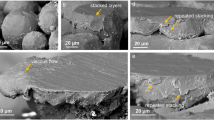Abstract
This paper develops an analytical model for the material removal rate during specimen polishing. The model is based on the micro-contact elastic mechanics, micro-contact elastic-plastic mechanics and abrasive wear theory. The micro-contact elastic mechanics between the pad-specimen surfaces used the Greenwood and Williamson elastic model. The micro-contact elastic-plastic mechanics between specimen and particle, as well as the micro-contact elastic mechanics between particle and pad, are also analyzed. The cross-sectional area of the worn groove in the specimen is considered as trapezoidal area. A close-form solution of material removal rate from the specimen surface is the function of average diameter of slurry particles, pressure, the specimen/pad sliding velocity, Equivalent Young’s modulus, RMS roughness of the pad, and volume concentration of the slurry particle.
Similar content being viewed by others
Abbreviations
- An :
-
Nominal contact area
- At :
-
Total real contact area
- C:
-
Removal rate constant
- CP :
-
Preston coefficient
- d:
-
Mean separation between pad and specimen based on asperity heights
- D:
-
Average diameter of slurry particles
- Epad :
-
Young’s modulus of pad
- Epar :
-
Young’s modulus of slurry particles
- Es :
-
Young’s modulus of specimen
- Espad :
-
Equivalent Young’s modulus between the specimen and the pad
- Espar :
-
Equivalent Young’s modulus between the specimen and the particle
- Epp :
-
Equivalent Young’s modulus between the particle and the pad
- H:
-
Hardness of softer material
- h:
-
Separation based on surface heights
- K:
-
Wear constant
- l:
-
Line density of particles in polishing slurry
- P:
-
Applied pressure (=Wt/An)
- q:
-
Area density of particles in polishing slurry
- R:
-
Asperity radius of curvature
- rc :
-
Radius of the circular indentation area of a particle on specimen surface due to elastic deformation
- rp :
-
Radius of the circular indentation area of a particle on specimen surface due to plastic deformation
- s:
-
Sliding distance
- t:
-
Polishing time
- V:
-
Sliding velocity between pad and specimen
- Wt :
-
Total contact load between pad and specimen
- x:
-
Particle volume concentration in polishing slurry
- ys :
-
Distance between the mean of asperity heights and that of surface heights
- z:
-
Height of an asperity measured from the mean of asperity heights
- ρ:
-
Material removal rate of specimen
- σ:
-
RMS roughness of the pad
- Φ:
-
Distribution function of asperity heights
- ξ:
-
Volume of an individual slurry particle
- δc :
-
Indentation depth of a particle in specimen due to elastic deformation
- δe :
-
Indentation depth of a particle in polishing pad
- δp :
-
Indentation depth of a particle in specimen due to plastic deformation
- υpad :
-
Poisson’s ratio of the pad
- υpar :
-
Poisson’s ratio of the slurry particles
- υs :
-
Poisson’s ratio of the specimen
- ω:
-
Local contact interference between pad and specimen
References
Suzuki K et al (1992) Development of a new mechanochemical polishing method with a polishing film for ceramic round bars. Ann CIRP 41(1):339–342
Xie Y, Bhushan B (1996) Effect of particle size, polishing pad and contact pressure in free abrasive polishing. Wear 200:281–295
Jiang M, Komanduri R (1997) Application of Taguchi method for optimization of finishing conditions in magnetic float polishing (MFP). Wear 213:59–71
Larsen-Basse J, Liang H (1999) Probable role of abrasion in chemo-mechanical polishing of tungsten. Wear 233–235:647–654
Sun J et al (2000) Material removal in the optical polishing of hydrophilic polymer materials. J Mater Process Technol 103:230–236
Luo J, Dornfeld DA (2001) Material removal mechanism in chemical mechanical polishing: theory and modeling. IEEE Trans Semicond Manufact 14(2):112–133
Fu G et al (2001) A plasticity -based model of material removal in Chemical Mechanical Polishing (CMP). IEEE Trans Semicond Manufact 14(4):406–417
Zhao Y, Chang L (2002) A micro-contact and wear model for chemical-mechanical polishing of silicon wafers. Wear 252:220–226
Lin S-C, Wu M-L (2002) A study of the effects of polishing parameters on material removal rate and non-uniformity. Int J Machine Tools Manuf 42:99–103
Wang C-C, Lin S-C, Hochen H (2002) A material removal model for polishing glass-ceramic and aluminum magnesium storage disks. Int J Machine Tools Manuf 42:979–984
Evans CJ et al (2003) Material removal mechanisms in lapping and polishing. Ann CIRP 52(2):611–633
Yuan JL et al (2003) Lapping and polishing process for obtaining super-smooth surfaces of quartz crystal. J Mater Process Technol 138:116–119
Greenwood JA, Williamson BP (1966) Contact of nominally flat surfaces. Proc R Soc Lond Ser A 295:300–319
Chang WR, Etsion I, Bogy DB (1987) An elastic-plastic model for the contact of rough surface. Trans ASME J Tribology 109:257–263
Rabinowicz E (1995) Friction and wear of materials, 2nd edn. Wiley, New York
Preston FW (1927) The theory and design of plate glass polishing machine. J Soc Glass Technol 11(44):214–256
Luo Q, Ramarajan S, Babu SV (1998) Modification of the Preston equation for the chemical-mechanical polishing of copper. Thin Solid Films 335:160–167
Author information
Authors and Affiliations
Corresponding author
Rights and permissions
About this article
Cite this article
Lin, TR. An analytical model of the material removal rate between elastic and elastic-plastic deformation for a polishing process. Int J Adv Manuf Technol 32, 675–681 (2007). https://doi.org/10.1007/s00170-005-0391-4
Received:
Accepted:
Published:
Issue Date:
DOI: https://doi.org/10.1007/s00170-005-0391-4



